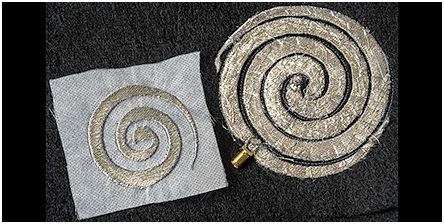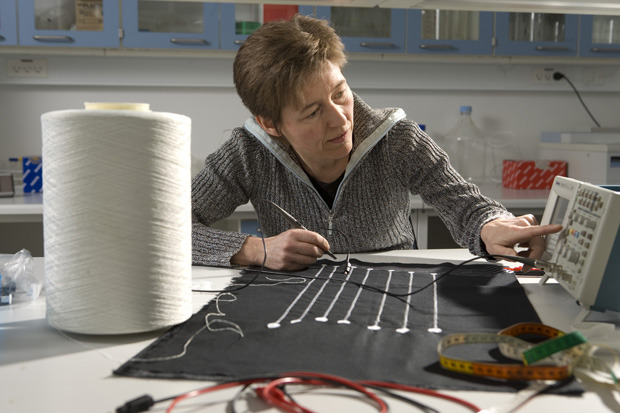Computers in your
Clothes? A Wearable Electronics
Milestone

Photo Courtesy of Jo McCulty, Ohio State University.
Ohio State University
Researchers are working to develop wearable electronics have reached
a milestone: They are able to embroider circuits into fabric with 0.1 mm
precision — the perfect size to integrate electronic components, such as
sensors and computer memory devices, into clothing.
These are clothes that
gather, store or transmit digital information. With further development, the
technology could lead to shirts that act as antennas for your smart phone or
tablet, workout clothes that monitor your fitness level, sports equipment that
monitors athletes’ performance, a bandage that tells your doctor how well the
tissue beneath it is healing — or even a flexible fabric cap that senses activity in the brain.
In the lab, the
functional textiles, also called “e-textiles,” are created in part on a typical
tabletop sewing machine — the kind that fabric artisans and hobbyists might
have at home. WOW! Like other modern sewing machines, it
embroiders thread into fabric automatically based on a pattern loaded via a
computer file. The researchers substitute the thread with fine silver metal
wires that, once embroidered, feel the same as traditional thread to the
touch.
“Shape determines
function,” she said. “And you never really know what shape you will need from
one application to the next. So, we wanted to have a technology that could embroider any shape for any
application.”
The researchers’
initial goal was just to increase the precision of the embroidery as
much as possible, which necessitated working with fine silver wire. But that
created a problem, in that fine wires couldn’t provide as much surface
conductivity as thick wires. So, they had to find a way to work the fine thread
into embroidery densities and shapes that would boost the surface
conductivity and, thus, the antenna/sensor performance.
Previously, the
researchers had used silver-coated polymer thread with a 0.5-mm diameter, each
thread made up of 600 even finer filaments twisted together. The new threads
have a 0.1-mm diameter (1/250th of an inch), made with only seven filaments.
Each filament is copper at the center, enameled with pure silver. And you
thought you had thread breaking issues. . .
My original thinking
for this app would be to have something that could have a GPS monitor for
finding lost people and things. After all, when someone might be taken away
from their environment unwillingly, finding them quickly is paramount.
I think this thread or
wire could be in your shopping basket in less than 10 years. But, I am not an
expert. I just think that the tech revolution and embroidery just may have a
partnership to save lives in addition to being decorative and utilitarian.
We have been seeing
these e-textiles around the Net. Here is one courtesy of Innovationintextiles.com,
Denmark. Somehow, it looks familiar to me.

Photo Courtesy Innovationsintextiles.com - Denmark

Washable fabric Circuit Board
In Ohio State
University's shopping list for the next phase of the project. “We want a bigger
sewing machine,” they indicated. Hmmm. . . .